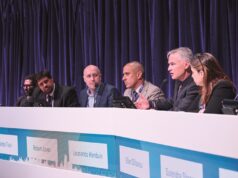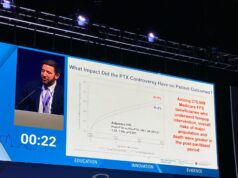 In the UK National Institute for Health and Care Research (NIHR) Health Technology Assessment (HTA)-funded BASIL-3 randomised controlled trial (RCT), neither drug-coated balloon (DCB) angioplasty with or without bare metal stent nor drug-eluting stent (DES), when used in the femoropopliteal segment, conferred a hypothesised clinical benefit over femoropopliteal plain balloon angioplasty with or without bare metal stent.
In the UK National Institute for Health and Care Research (NIHR) Health Technology Assessment (HTA)-funded BASIL-3 randomised controlled trial (RCT), neither drug-coated balloon (DCB) angioplasty with or without bare metal stent nor drug-eluting stent (DES), when used in the femoropopliteal segment, conferred a hypothesised clinical benefit over femoropopliteal plain balloon angioplasty with or without bare metal stent.
In addition, it was found that DCB with or without bare metal stent is unlikely to be cost-effective at the UK National Health Service (NHS) National Institute for Health and Care Excellence (NICE) willing-to-pay threshold. DES, on the other hand, is potentially cost-effective at this threshold.
Andrew Bradbury (Birmingham, United Kingdom) and the BASIL-3 team of triallists shared this and other key findings on Tuesday afternoon, addressing the question of which endovascular strategy is best in the femoropopliteal segment. The investigators presented—for the very first time—the results of this long-awaited, only completed, fully publicly funded RCT in the space.
“This was a pragmatic, ‘real-world’ UK trial whose outcomes are likely to be a realistic representation of what can be reasonably achieved across the NHS,” Bradbury shared during the session.
Following an introduction to the trial from Bradbury, Lewis Meecham (Cardiff, Wales) shared evidence for paclitaxel DCB and DES in chronic limb-threatening ischaemia (CLTI) before BASIL-3; Matthew Popplewell (Birmingham, United Kingdom) put the trial into context, speaking specifically about the BASIL Prospective Cohort Study (PCS); and Gareth Bate (Birmingham, United Kingdom) and Jack Hall (Birmingham, United Kingdom) shared BASIL-3 clinical and statistical methodology, respectively.
Against this backdrop, Catherine Moakes (Birmingham, United Kingdom) reported clinical results of the BASIL-3 trial.
Between 29 January 2016 and 26 August 2021, the trial enrolled 481 patients, with 160 randomised to plain balloon angioplasty with or without bare metal stent, 161 to DCB with or without bare metal stent, and 160 to DES.
In the intention-to-treat analysis, Moakes revealed that 54 (34%) patients in the plain balloon angioplasty group met the primary endpoint of amputation-free survival (AFS), defined as the time to major (above-the-ankle) amputation of the index limb or death from any cause, compared to 64 (40%) in the DCB arm and 66 (42%) in the DES arm.
In a per-protocol analysis of only adherent participants, Moakes reported that 49/140 (35%) patients in the plain balloon angioplasty group met the AFS endpoint, compared to 48/122 (39%) in the DCB group and 47/118 (40%) in the DES group.
The research group also shared health economic outcomes. In a cost-utility analysis, Jesse Kigozi (Birmingham, United Kingdom) outlined that DCB angioplasty with or without bare metal stent when compared to plain balloon angioplasty with or without bare metal stent was less costly by £-250.71 and less effective by -0.007 quality-adjusted life years (QALYs).
Kigozi then shared health economic results comparing the DES group versus plain balloon angioplasty. In the cost-utility analysis, the differences observed in the costs and outcomes between DES and plain balloon angioplasty with or without bare metal stent[1]first strategies were minimal, he reported.
However, Kigozi added that DES was the dominant strategy because, when compared to plain balloon angioplasty with or without bare metal stent, DES was less costly by £-724 and resulted in additional 0.048 QALY.
Kigozi summarised that there were minimal incremental differences in costs and outcomes in terms of QALYs out to two years and amputation-free life years out to seven years when the DCB with or without bare metal stent or the DES-first revascularisation strategies were compared to the plain balloon angioplasty with or without bare metal stent-first strategy in the cost-utility and cost-effectiveness analysis.
Kigozi said that, while there is uncertainty overall, the results show DCB is unlikely to be cost-effective when compared to plain balloon angioplasty, while DES is potentially cost-effective when compared to plain balloon angioplasty. He added that these findings were generally consistent over different scenarios and analyses and across different patient subgroups.
Finally, Bradbury summed up the main findings and underscored limitations, take-home messages, and further research.
He stressed that the trial’s power exceeds 90%, with more than the 291 required primary outcomes observed. Bradbury added that follow-up was long and better than anticipated, with only seven patients withdrawing prior to the primary endpoint. Cause of death was available for all deceased patients, he continued, adding also that most (35) UK vascular units randomised patients.
Bradbury also outlined some potential limitations of the trial, highlighting among these the effects of the “Katsanos pause”— referring to the fallout from the controversial 2018 meta-analysis on paclitaxel-coated devices—and the effects of COVID-19.
Discussion following the presentations included examination of the choice of AFS as the primary endpoint.
William Gray (Philadelphia, United States) asked, for example, why AFS was chosen versus another endpoint like major amputation “given the dominance of death” in this patient population.
Bradbury responded that there was a lot of support in the UK for AFS. “I’m not saying it’s the only endpoint, but it’s the one that we’ve chosen, and it runs through all three BASIL trials rightly or wrongly,” he said. “In BASIL-1 and BASIL-2, we have actually found that the biggest difference between the two groups is mortality and not amputation rate.”
Michael Conte (San Francisco, United States) added that there have now been three BASIL trials, but not one has shown a difference in limb outcomes. “While I recognise that AFS is a critical endpoint, I think the way in which you’ve powered it doesn’t take into account that death is a noise and the outcome in the limb is what you’re actually looking to differentiate.”
CX co-chair Andrew Holden (Auckland, New Zealand), who co-moderated the session, asked Bradbury what should be taken away from these trial results in 2024. “We would like to have had a more clear-cut result,” he admitted. “Maybe over the next few days, weeks, months, as we digest it, as the publications come out and as we present more data, people will begin to think about what it means for their practice, in their country, in their healthcare system.”











